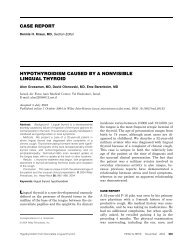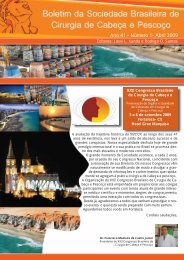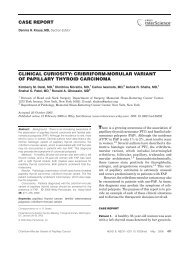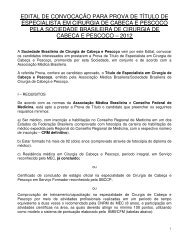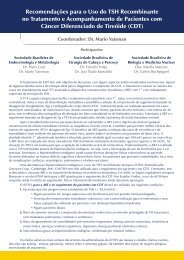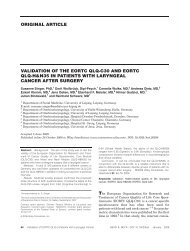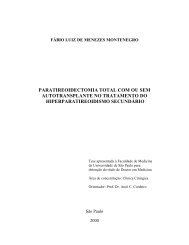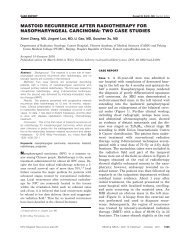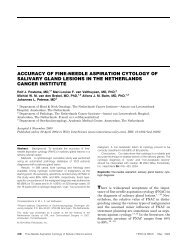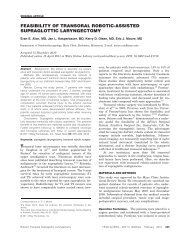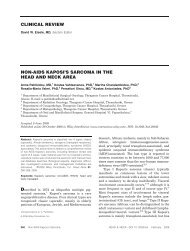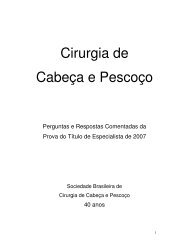Radiation-induced xerostomia
Radiation-induced xerostomia
Radiation-induced xerostomia
You also want an ePaper? Increase the reach of your titles
YUMPU automatically turns print PDFs into web optimized ePapers that Google loves.
Patients often resort to complementary and<br />
alternative medicine for primary or adjunct<br />
therapies. In particular, acupuncture has gained<br />
significant momentum in current research, after<br />
reports of successful palliation of <strong>xerostomia</strong><br />
appeared in the West as early as 1981. 9 A regimen<br />
of 3 or 4 weekly sessions followed by monthly<br />
maintenance sessions was recommended in 1<br />
open-label study of 50 patients, although some<br />
patients achieved lasting remission without further<br />
therapy. 25 This approach has yet to be tested<br />
in a prospective randomized trial.<br />
Promising preliminary data were reported<br />
from a group of patients with strictly defined<br />
pilocarpine-resistant radiation-<strong>induced</strong> <strong>xerostomia</strong>.<br />
9,25 While the precise mechanism of action of<br />
acupuncture is still unknown, autonomic stimulation<br />
by the acupuncture needles is presumed to be<br />
at least partially responsible for the effect,<br />
although different acupuncture points and techniques<br />
have been used. 9 Other investigators have<br />
reported equally promising results using noninvasive<br />
transcutaneous electrical nerve stimulation<br />
(TENS) of acupuncture points with either traditional<br />
TENS or the newer proprietary Codetron<br />
technique. 3<br />
Surgical relocation of the submandibular<br />
gland to the submental space, before radiation<br />
therapy, was recently proposed as a novel way to<br />
preserve salivary function and prevent <strong>xerostomia</strong>.<br />
12,26 Approximately 200 to 300 mL/day of<br />
saliva, or about 15% to 30% of normal daily output,<br />
is produced by the submandibular salivary<br />
glands. 12,26 A Canadian group has suggested that<br />
surgically transferring the submandibular gland,<br />
before irradiation, to the submental space, which<br />
is shielded from all but 5% of the total radiation<br />
dose, can preserve its function. They performed<br />
the procedure in 24 eligible patients who maintained<br />
a salivary flow rate, ranging from 29% to<br />
þ12% of the preoperative rate, and good subjective<br />
patient-benefit scores. This report represents<br />
proof of the principle that the physical sparing of<br />
the submandibular gland can lead to reduction of<br />
<strong>xerostomia</strong> rates. However, the reproducibility<br />
and safety of this procedure remain to be confirmed,<br />
as there is a potential risk of co-transferring<br />
tumor cells to the submental ‘‘safe haven,’’ as<br />
occurred in 1 patient in the study. 26 The <strong>Radiation</strong><br />
Therapy Oncology Group is currently investigating<br />
this technique.<br />
The current treatment of choice for patients<br />
with remaining functional acinar tissue involves<br />
the use of parasympathomimetic secretagogues. 11<br />
These agents stimulate the M3 muscarinic receptors<br />
found in salivary glands, leading to increased<br />
saliva secretion, and thus offer a more<br />
physiologic treatment for the symptoms of <strong>xerostomia</strong><br />
than saliva substitutes. Pilocarpine is<br />
currently the only secretagogue approved by the<br />
FDA for the symptomatic treatment of postirradiation<br />
<strong>xerostomia</strong> and is also approved for the<br />
treatment of dry mouth symptoms associated<br />
with Sjögren syndrome. 27 In a randomized controlled<br />
trial involving 207 patients with radiation-<strong>induced</strong><br />
<strong>xerostomia</strong>, pilocarpine 5 mg 3<br />
times per day (tid) improved oral dryness in 44%<br />
of treated patients compared with 25% of placebo<br />
recipients (p ¼ .027). Similar improvement was<br />
seen with a dose of 10 mg tid (46, p ¼ .020). Furthermore,<br />
patients in both treatment groups<br />
experienced improvement in the overall condition<br />
of <strong>xerostomia</strong> (p ¼ .010) and mouth and<br />
tongue comfort (p ¼ .001). 28 Another study has<br />
shown that pilocarpine can also be efficacious<br />
when dissolved in artificial saliva and administered<br />
in a mouth spray, provided there is residual<br />
salivary function. 7 Pilocarpine mouthwash, when<br />
compared in a crossover randomized study with a<br />
mucin-based saliva substitute, was found to be<br />
efficacious after 3 months of treatment, leading to<br />
a mean change in the <strong>xerostomia</strong> score in 22.5% of<br />
patients compared with 15.2% of patients using<br />
artificial saliva alone. 27 Preliminary animal data<br />
suggested that administration of pilocarpine<br />
before or during irradiation could provide protection<br />
against the development of <strong>xerostomia</strong>. 17 Subsequently,<br />
human studies were conducted to verify<br />
this observation; whereas the protective effect<br />
seemed to be reproduced in a few small trials, 27,29<br />
others failed to demonstrate either a symptomatic<br />
improvement accompanying the maintained salivary<br />
flow rate or any preventive action at all. 30<br />
The use of pilocarpine may be limited in some<br />
patients by side effects and contraindications that<br />
stem from its fundamental mechanism of action,<br />
muscarinic-cholinergic agonism with mild b-cholinergic<br />
activity. The secretory activity of exocrine<br />
glands other than the salivary glands and the<br />
smooth muscle tone of the gastrointestinal and<br />
genitourinary tracts are increased. 27 As a result,<br />
the use of pilocarpine is contraindicated in patients<br />
with uncontrolled asthma, acute iritis, and<br />
narrow-angle glaucoma. Pilocarpine should also<br />
be prescribed cautiously for patients with a<br />
history of severe cardiovascular disease or with<br />
biliary disease, gastric ulcer, nephrolithiasis,<br />
or diarrhea. 31 The most frequent adverse effects<br />
<strong>Radiation</strong>-Induced Xerostomia HEAD & NECK—DOI 10.1002/hed January 2007 61



